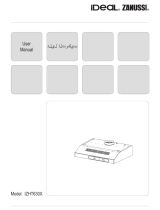
2
Part 1 - INSTALLATION INSTRUCTIONS
1 - GENERAL INFORMATION
This hood is designed to be fixed to any rigid vertical surface, over a gas or electric hotplate and can
be used either in the extraction mode (ducted to the outside) or in the recirculation mode (internal
recycling).
Before commencing the installation, consideration should be given to the difficulties to be found
during installation.
The installation work must be undertaken by a qualified and competent person in conformity to
the rules concerning the evacuation of contaminated air.
The manufacturer disclaims all liability for any damage or injury caused as a result of not
following the instructions for installation contained in the following text.
2 - SAFETY WARNINGS
2.1 - When used in the extraction mode, the cooker hood ducting must not be connected to a flue
which is used for exhausting fumes from appliances supplied with energy other than electric,
such as a central heating flue or water heating flue.
2.2 - Before connecting to the mains supply ensure that the mains voltage corresponds with the voltage
on the rating plate inside the hood.
2.3 - Connect the cooker hood to the mains via a bipolar switch which has 3 mm clearance between
the contacts.
2.4 - For cooker hoods featuring an earth cable, make sure the electric plant of your house is correctly
earthed.
2.5 - Appliances in class II are provided with a double insulation; therefore do not connect them
through earthed plugs but through simple bipolar plugs.
2.6 - When installed, the hood must be positioned at least 65 cm above the hotplate.
2.7 - Never do flambé cooking under this cooker hood.
2.8 - Never leave frying pans unattended during use as overheated fat and oil may catch fire.
2.9 - Before carrying out any kind of maintenance or cleaning, disconnect the hood from the mains
supply.
2.10 -
If the room where the cooker hood is to be used contains a fuel burning appliance such as a
central heating boiler then this must be of the room sealed or balanced flue type.
If other types of flue or appliance are fitted, ensure that there is an adequate supply of air into
the room.
When the cooker hood is used in conjunction with appliances supplied with energy other than
electric, the negative pressure in the room must not exceed 0,04 mbar to prevent fumes being
drawn back into the room by the cooker hood.
3 - INSTALLATION
3.1 - Fixing the front panel to the screen
Extract the metal screen by turning it outwards unlocking, at the same time the stop on the left hand
side of the hood (fig. 1), drill the panel, using the cardboard template provided and fix it to the screen
using the 3.9 x 13 screws provided. Replace the screen, ensuring that the guides are fitted correctly into
position.
Adjust the slide of the screen by turning the two screws V.
3.2 - Fixing to the wall
Drill the wall using the cardboard template provided, fit plugs into the holes and fix the two metal
brackets using the four screws provided with the accessories.
Hook the hood onto the metal brackets.
The rear hooks on the hood can be adjusted both in height and depth, allowing the hood to be aligned








